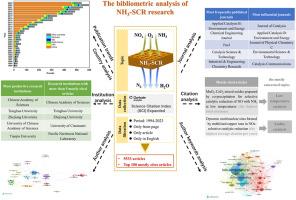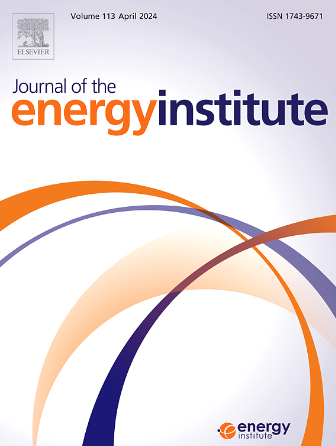Global trends on NH3-SCR research for NOx control during 1994–2023: A bibliometric analysis
IF 5.6
2区 工程技术
Q2 ENERGY & FUELS
引用次数: 0
Abstract
Selective catalytic reduction technology with NH3 as reducing agent (NH3-SCR) has been widely applied to remove NOx from stationary sources and diesel vehicles. In this paper, we conducted a bibliometric analysis to understand the research trends in NH3-SCR fields during 1994–2023. The article number was thriving, especially in China. China and USA were the predominant countries with close collaboration relationship. Chinese Academy of Sciences, Tsinghua University and Zhejiang University made greatest contributions, and Politecnico di Milano had strong academic influence. Li, Junhua was prominent author with publishing most articles and mostly cited articles. The stable core author groups had been developed, whose research focuses were identified. Applied Catalysis B: Environment and Energy was the leading journal. The analysis of most frequently cited articles and most frequently used author keywords found six main research domains, including of the low-temperature catalysts, the transition metal modified zeolites, the V-based catalysts, the deactivation and regeneration, the multi-pollutants removal, the aftertreatment system of diesel vehicles and their mechanism studies. Cu-SSZ-13, DFT, the synergistic effect and the simultaneous removal of NOx and other air pollutants got recent attentions. These findings enriched the understandings in NH3-SCR fields, giving some guidelines for the future research.

1994-2023 年期间全球氮氧化物控制 NH3-SCR 研究趋势:文献计量分析
以 NH3 为还原剂的选择性催化还原技术(NH3-SCR)已被广泛应用于去除固定污染源和柴油车辆中的氮氧化物。本文进行了文献计量分析,以了解 1994-2023 年间 NH3-SCR 领域的研究趋势。文章数量呈增长趋势,尤其是在中国。中国和美国是合作关系密切的主要国家。中国科学院、清华大学和浙江大学的贡献最大,米兰理工大学也有很强的学术影响力。李俊华是发表文章最多、被引用最多的著名作家。已经形成了稳定的核心作者群,其研究重点已经确定。应用催化 B:环境与能源》是主要期刊。通过分析被引用次数最多的文章和作者最常使用的关键词,发现了六个主要研究领域,包括低温催化剂、过渡金属改性沸石、V 型催化剂、失活与再生、多污染物去除、柴油车后处理系统及其机理研究。最近,Cu-SSZ-13、DFT、协同效应以及同时去除氮氧化物和其他空气污染物的研究受到了关注。这些发现丰富了人们对 NH3-SCR 领域的认识,为今后的研究提供了一些指导。
本文章由计算机程序翻译,如有差异,请以英文原文为准。
求助全文
约1分钟内获得全文
求助全文
来源期刊

Journal of The Energy Institute
工程技术-能源与燃料
CiteScore
10.60
自引率
5.30%
发文量
166
审稿时长
16 days
期刊介绍:
The Journal of the Energy Institute provides peer reviewed coverage of original high quality research on energy, engineering and technology.The coverage is broad and the main areas of interest include:
Combustion engineering and associated technologies; process heating; power generation; engines and propulsion; emissions and environmental pollution control; clean coal technologies; carbon abatement technologies
Emissions and environmental pollution control; safety and hazards;
Clean coal technologies; carbon abatement technologies, including carbon capture and storage, CCS;
Petroleum engineering and fuel quality, including storage and transport
Alternative energy sources; biomass utilisation and biomass conversion technologies; energy from waste, incineration and recycling
Energy conversion, energy recovery and energy efficiency; space heating, fuel cells, heat pumps and cooling systems
Energy storage
The journal''s coverage reflects changes in energy technology that result from the transition to more efficient energy production and end use together with reduced carbon emission.
 求助内容:
求助内容: 应助结果提醒方式:
应助结果提醒方式:


